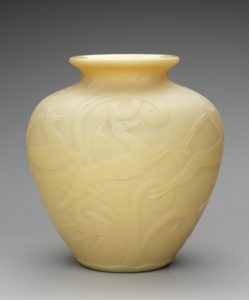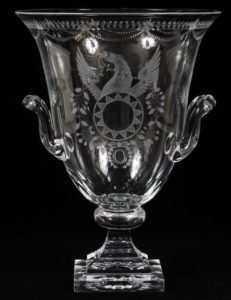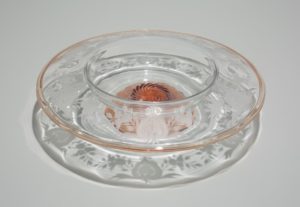Frederick Carder Glass Given to the Detroit Institute of Arts
By BENJAMIN COLMAN,
Associate Curator of American Art, Detroit Institute of Arts
The Detroit Institute of Arts (DIA) was recently gifted a focused collection of 1920s glass designed by Frederick Carder for Steuben Glass Works that opens a window onto a fascinating moment in the history of American art glass. This important gift was made by Dr. Robert Bernstein and Arlene Lullove, who through meticulous research, and a good dose of patient searching, built one of the premier collections of early Steuben glass in private hands.
Prior to this gift, the DIA had only a single piece of glass Carder designed for Steuben. Through the generosity of Dr. Burnstein and Ms. Lullove, who live in suburban Detroit, the museum can now present a more complete picture of Carder’s influence on early-20th-century American glass, including the cultural and stylistic influences shaping American design in the 1920s. Under Carder’s leadership, Steuben embraced eclectic styles ranging from the conservatism of the lingering Beaux Arts influences, to the progressive geometry of European modernism, the international influence of Art Deco, and the homegrown historicist taste for the American Colonial Revival.
Carder co-founded Steuben Glass Works in 1903 in rural Corning, NY, with Thomas J. Hawkes, and ran the company until 1918 when it was purchased by, and became a division of, Corning Glass Works. Carder was an English-trained glass artist who brought a chemist’s approach to Steuben, developing a perfectly clear, dazzlingly bright glass in a bold array of colors. His careful testing and refining of recipes and exacting demands for superior craftsmanship resulted in ambitious, hand-wrought forms with precise engraving, deep acid-etching, luxuriously saturated colors, and glittering metallic surfaces. Carder served as artistic director of the Steuben division until 1932.
American popular design of the period was decidedly ambivalent. Then, as now, the newest ideas were tempered with the lingering influence of the familiar. Unlike other companies that cultivated a distinct, identifiable, and easily branded style, Steuben attempted to bridge this gap with eclectic offerings. The “Van Dyck” pattern (Fig. 1) engraved on a ca. 1926 centerbowl reveals a lingering taste for historically inflected patterns with scrolling foliage, blossoms, and Baroque c-scrolls. The Art Deco-style “Stamford” vase (Fig. 2) in alabaster glass features a gracefully abstracted pattern of leaping gazelles. The craftsmen created crisp lines, a smooth surface, and deep relief of the images using an acid etching technique that became Steuben’s hallmark in the period.
This fruitful admixture of new and old led to truly hybrid objects, such as the Colonial Revival “Strawberry Mansion” urn (Fig 3) designed in 1931 to commemorate the restoration of the 1789 Philadelphia mansion by that name. The simplified, classical form appealed to modern tastes, while the patriotic engraving resonated with a conservative cultural impulse.
Taken together, this collection offers a striking view of a tense moment in the history of American decorative arts and design, torn between competing desires for the excitement of the new and the comfort of the old.
By BENJAMIN COLMAN,
Associate Curator of American Art, Detroit Institute of Arts
The Detroit Institute of Arts (DIA) was recently gifted a focused collection of 1920s glass designed by Frederick Carder for Steuben Glass Works that opens a window onto a fascinating moment in the history of American art glass. This important gift was made by Dr. Robert Bernstein and Arlene Lullove, who through meticulous research, and a good dose of patient searching, built one of the premier collections of early Steuben glass in private hands.
Prior to this gift, the DIA had only a single piece of glass Carder designed for Steuben. Through the generosity of Dr. Burnstein and Ms. Lullove, who live in suburban Detroit, the museum can now present a more complete picture of Carder’s influence on early-20th-century American glass, including the cultural and stylistic influences shaping American design in the 1920s. Under Carder’s leadership, Steuben embraced eclectic styles ranging from the conservatism of the lingering Beaux Arts influences, to the progressive geometry of European modernism, the international influence of Art Deco, and the homegrown historicist taste for the American Colonial Revival.
Carder co-founded Steuben Glass Works in 1903 in rural Corning, NY, with Thomas J. Hawkes, and ran the company until 1918 when it was purchased by, and became a division of, Corning Glass Works. Carder was an English-trained glass artist who brought a chemist’s approach to Steuben, developing a perfectly clear, dazzlingly bright glass in a bold array of colors. His careful testing and refining of recipes and exacting demands for superior craftsmanship resulted in ambitious, hand-wrought forms with precise engraving, deep acid-etching, luxuriously saturated colors, and glittering metallic surfaces. Carder served as artistic director of the Steuben division until 1932.
American popular design of the period was decidedly ambivalent. Then, as now, the newest ideas were tempered with the lingering influence of the familiar. Unlike other companies that cultivated a distinct, identifiable, and easily branded style, Steuben attempted to bridge this gap with eclectic offerings. The “Van Dyck” pattern (Fig. 1) engraved on a ca. 1926 centerbowl reveals a lingering taste for historically inflected patterns with scrolling foliage, blossoms, and Baroque c-scrolls. The Art Deco-style “Stamford” vase (Fig. 2) in alabaster glass features a gracefully abstracted pattern of leaping gazelles. The craftsmen created crisp lines, a smooth surface, and deep relief of the images using an acid etching technique that became Steuben’s hallmark in the period.
This fruitful admixture of new and old led to truly hybrid objects, such as the Colonial Revival “Strawberry Mansion” urn (Fig 3) designed in 1931 to commemorate the restoration of the 1789 Philadelphia mansion by that name. The simplified, classical form appealed to modern tastes, while the patriotic engraving resonated with a conservative cultural impulse.
Taken together, this collection offers a striking view of a tense moment in the history of American decorative arts and design, torn between competing desires for the excitement of the new and the comfort of the old.



